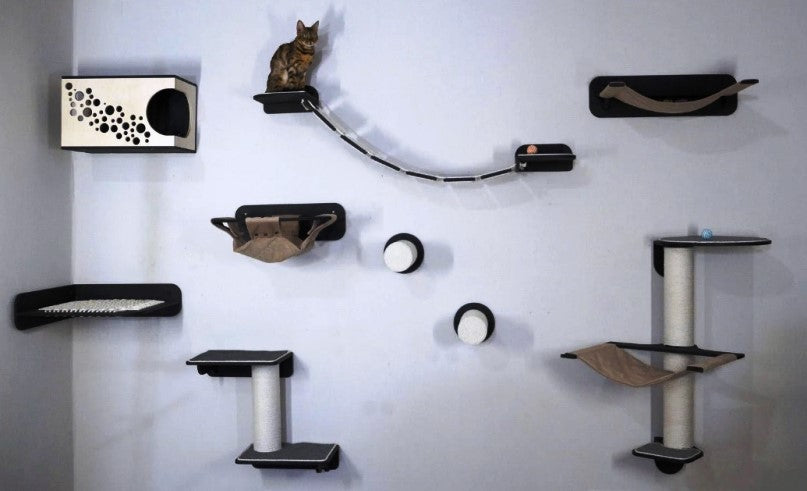In this Article
Keeping an energetic cat entertained and physically active is both a challenge and a joy for cat owners. Cats are natural climbers, hunters and explorers, with instincts honed for navigating complex environments. A wall-mounted playground is an innovative way to channel their energy, satisfy their curiosity, and provide a stimulating environment in the safety of your home. This guide offers a comprehensive, expert-led approach to designing and building a wall-mounted playground for your cat, tailored for enthusiasts who already share their home with a feline friend. With expert insights and practical steps, we'll ensure that your cat's new playground is safe, engaging, and built to last.
Why a wall playground?
Cats thrive in three-dimensional spaces. Unlike dogs, which are more ground-oriented, cats seek out vertical areas to observe, rest, and play. A wall-mounted playground taps into their natural desire to climb, jump, and view their territory from a height. According to a 2024 study by the American Association of Feline Practitioners, environmental enrichment significantly reduces stress and behavioral problems in indoor cats, such as excessive scratching or aggression. By providing a dedicated space for climbing and exploration, you're not only keeping your cat physically fit, but also mentally stimulated.
"Creating vertical spaces for cats is one of the most effective ways to enrich their environment," says Dr. Elena Klyusovets, a feline behaviorist and author of On the Same Wavelength with Your Cat. "Wall routes allow cats to express their natural behaviors, such as climbing and perching, which are essential to their emotional and physical well-being."
A well-designed wall route can also save floor space, making it ideal for apartments or homes with limited space. It encourages exercise, which is essential for preventing obesity - a growing problem, with more than 60% of domestic cats in the U.S. classified as overweight, according to the Association for Pet Obesity Prevention (2025 data). It can also protect furniture by redirecting scratching and climbing instincts to a designated area.
Planning Your Wall Playground
Before a single nail is hammered, careful planning will ensure that the playground is safe, functional, and appealing to your cat. Here are the key steps to consider:
1. Assess your cat's needs and personality
Every cat is unique. An energetic cat may enjoy high jumps and fast tracks, while a more cautious cat may prefer lower platforms with gradual inclines. Observe your cat's behavior:
- Does your cat jump on high surfaces like countertops or bookshelves? She'll probably enjoy a challenging route with varying heights.
- Does she scratch furniture or walls? Include scratching posts or surfaces.
- Are they social or solitary? Social cats may enjoy perches near windows or family areas, while shy cats may prefer quieter corners.
Also consider age and health. Kittens and young adults can handle more challenging setups, while older cats benefit from gentler slopes and wider platforms. Consult a veterinarian if your cat has mobility issues, as noted in a 2024 article on holistic-shop.ru that emphasizes checking for signs of pain during play.
2. Evaluate your space
Measure the wall space you'll need for the playground. A typical course may be 6-12 feet horizontally and 3-6 feet vertically, depending on your home. Key considerations include
- Wall material: Drywall or plaster walls require strong anchors (such as toggle studs) to support the weight. Stud finder tools are essential to locate safe attachment points.
- Safety Zones: Make sure the route avoids hazards such as electrical outlets, fragile decorations, or unshielded windows. Clear nearby surfaces to prevent falls on sharp objects.
- Accessibility: Place the route in an area your cat already frequents, such as near a favorite window or couch, to encourage use.
3. Design the route
A good wall playground combines elements that mimic a cat's natural environment:
- Platforms: Flat surfaces for resting or observation, spaced vertically 1-3 feet apart to allow safe jumping.
- Ramps and Bridges: Sloped or rope-covered ramps for climbing, connecting platforms.
- Scratching Areas: Sisal rope or carpet-covered panels to satisfy scratching instincts.
- Perches and Hideaways: Small dens or hammocks for lounging or hiding, appealing to a cat's love of cozy places.
- Interactive Elements: Dangling toys, feather teasers, or treat-dispensing puzzles to stimulate the hunting instinct.
Design the run to flow naturally, with gradual changes in elevation and multiple entrances and exits. A zigzag or spiral pattern can maximize space and keep the cat occupied. Make sure the platforms are at least 12x12 inches to accommodate most cats comfortably.
Building the Playground
With a plan in place, it's time to gather materials and start building. Here's a step-by-step guide to creating a durable, cat-friendly wall route.
Materials needed
- Wooden platforms: Plywood or pine boards (½ inch thick, cut to size).
- Sisal rope or carpet: For scratching surfaces and ramps.
- Brackets and Anchors: L-shaped corner brackets and heavy-duty drywall anchors (rated at least 50 lbs each).
- Screws and drill: For attaching components to the wall.
- Hammocks or fabric: Pet-safe, durable materials like canvas or fleece for cozy perches.
- Toys: Feathers, bells, or treat dispensers for interactivity.
- Tools: Stud finder, level, tape measure, sandpaper (to smooth edges), and paint (nontoxic, pet-safe).
Total cost can range from $50 to $200, depending on whether you repurpose materials or buy new. For budget-conscious owners, Lifehacker.ru suggests using recycled cardboard or furniture scraps for platforms.
Construction Steps
-
Mark stud locations : Use a stud finder to locate wall studs for secure mounting. Mark with a pencil.
-
Cut and Prepare Platforms: Cut plywood to desired sizes (e.g., 12x12 inches for platforms, 12x24 inches for ramps). Sand edges to prevent splinters.
-
Cover surfaces: Wrap platforms or ramps with carpet or sisal rope and secure with nontoxic glue or staples. Make sure there are no sharp edges.
-
Install the brackets: Attach L-brackets to the wall at stud locations using anchors and screws. Use a level to ensure platforms are level.
-
Mounting Platforms and Ramps: Secure platforms to brackets. For ramps, angle them at 30-45 degrees for safe climbing.
-
Add interactive elements: Attach dangling toys or treat dispensers to platforms. Make sure they are securely fastened to prevent choking hazards.
-
Test for stability: Gently press on each component to make sure it can support your cat's weight (typically 8-15 lbs for an adult cat). Reinforce as needed.
Security Checks
- Stability: None of the components should move under pressure.
- Smooth edges: No sharp corners or loose screws.
- Non-toxic materials: Use pet-safe paints and adhesives.
- Weight Capacity: Test with a weight heavier than your cat to ensure durability.
Introduce your cat to the playground
Once the playground is built, introduce it gradually to ensure that your cat feels comfortable using it. "Cats are naturally cautious, so patience is key when introducing new environments," says Jackson Galaxy, a renowned cat behaviorist and author of Catification for Satisfaction. "Use positive reinforcement, such as treats or play, to make the space inviting."
-
Scent Familiarization: Rub a rag on your cat's cheeks (where the scent glands are) and wipe it on the playground to mark it with your scent.
-
Lure with treats: Place treats or toys on lower platforms to encourage exploration. Gradually move them higher as your cat gains confidence.
-
Play sessions: Use a wand toy to guide your cat along the route, mimicking prey movements to trigger her hunting instincts, as suggested by murkosha.ru.
-
Monitor behavior: Watch for signs of stress (e.g., pinched ears, dilated pupils) and adjust the route as needed, such as lowering platforms for reluctant cats.
Maintenance and Updates
Regular maintenance keeps your playground safe and fun:
- Inspect weekly: Check for loose screws, frayed cables, or worn surfaces.
- Clean regularly: Vacuum or wipe down platforms to remove fur and dust. Wash fabric elements monthly.
- Rotate toys: Replace dangling toys or add new items every few months to maintain interest.
- Adapt as needed: As your cat ages or preferences change, adjust the platform height or add softer surfaces for comfort.
Why it's worth the effort
A wall-mounted playground transforms your home into a feline paradise, reducing boredom and promoting health. Energetic cats especially benefit from the physical and mental challenges of climbing and exploring. By tapping into their natural instincts, you'll promote a happier, healthier pet. Plus, watching your cat jump, pounce, and lounge on her custom-made track is endlessly rewarding for any cat lover.
With careful planning, quality materials, and a touch of creativity, your Wall Playground will become the center of your cat's daily adventures. Whether it's a daring leap to a high perch or a cozy nap in a wall-mounted hammock, your cat will thank you for a space that's truly his or her own.

